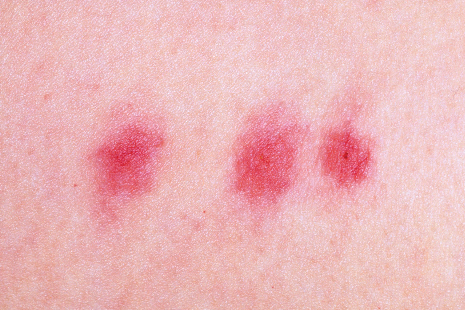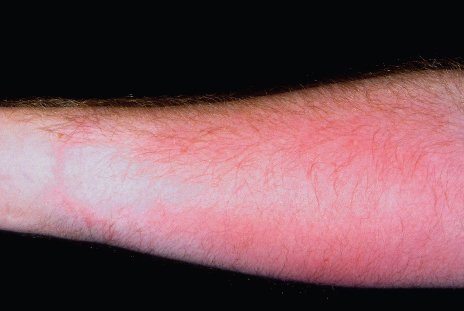 An insect bite normally appears as an itchy, red, swollen weal that may weep, particularly if it is scratched open (pictured, right). A sting (i.e. from a wasp or bee) is painful and often red and swollen (picture, below right). If a person is stung by a bee, the sting may still be left in the skin and it is best to remove it as soon as possible.
An insect bite normally appears as an itchy, red, swollen weal that may weep, particularly if it is scratched open (pictured, right). A sting (i.e. from a wasp or bee) is painful and often red and swollen (picture, below right). If a person is stung by a bee, the sting may still be left in the skin and it is best to remove it as soon as possible.
 Bites and stings don't usually cause serious health problems, although some people may have a severe allergic reaction (anaphylactic shock) to a sting, which can be potentially fatal. Warning signs for customers to look out for include swollen eyes, lips and mouth; difficulty breathing; large red weals on the skin; dizziness, and tightness of the chest.
Bites and stings don't usually cause serious health problems, although some people may have a severe allergic reaction (anaphylactic shock) to a sting, which can be potentially fatal. Warning signs for customers to look out for include swollen eyes, lips and mouth; difficulty breathing; large red weals on the skin; dizziness, and tightness of the chest.
In some countries, mosquito bites carry the risk of diseases such as malaria and yellow fever. The symptoms of malaria are similar to those of flu and tend to appear between 10 days to four weeks after the initial bite. However, in some cases it can take a year before the symptoms start to show. Any customer who has recently returned from a tropical holiday or has travelled to a sub-Saharan country and has flu-like symptoms should be referred to the pharmacist.
It is important that anyone travelling to an area that's at risk of malaria takes the appropriate antimalarial drugs before, during and for the correct amount of time after their trip.
In addition, you should recommend customers use an insect repellent containing DEET. Example: Jungle Formula. The suitability of these products for younger children should be checked. Sleeping under a mosquito net and wearing longsleeved clothing after dusk can also reduce the risk of bites.
